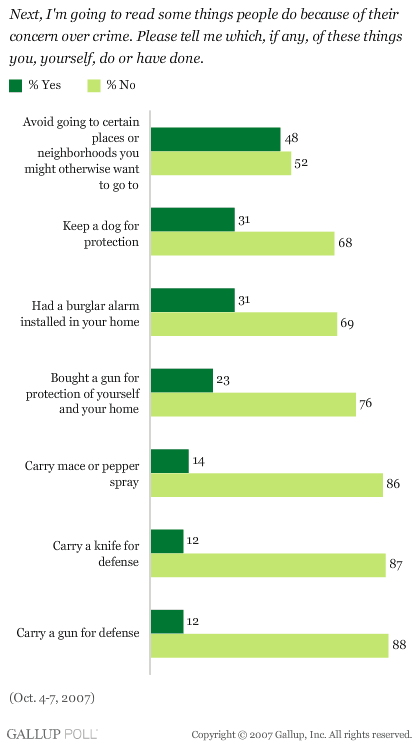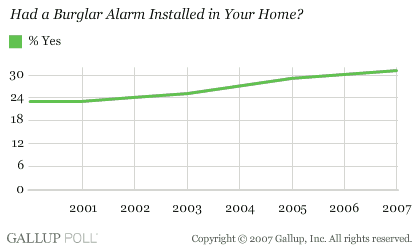PRINCETON, NJ -- Of seven different things Americans can do to protect themselves against crime, a recent Gallup Poll finds them most likely to say they avoid going to certain places or neighborhoods that they might otherwise want to go to. Americans are least likely to say they carry a weapon for defense, such as mace or pepper spray, a knife, or a gun. The percentage of Americans who have installed an alarm system in their homes has gradually increased over the past seven years and is at its highest point to date.
Americans who have been crime victims in the past year are much more likely than others to say they have done each of the seven things listed in the poll to protect themselves against crime. Men and women, as well as younger and older Americans, differ in some of the actions they take over concerns about crime. Republicans and Southerners are among the most likely groups to say they own a gun for protection against crime.
Overall Results
Gallup's annual Crime poll, conducted Oct. 4-7, 2007, finds that 48% of Americans say they avoid going to certain neighborhoods or areas that they might otherwise want to go to because of concerns about crime. Nearly one in three say they keep a dog for protection (31%) or have installed a burglar alarm in their homes (31%), and 23% say they have purchased a gun to protect themselves and their homes. Relatively few say they personally carry mace or pepper spray (14%), a knife (12%), or a gun for defense (12%).

There has been little change in what Americans report doing over their concerns about crime since Gallup first started tracking this measure in 2000. There is one exception, however. The percentage of Americans who report having had a burglar alarm installed in their homes has been gradually increasing over the past seven years, and is now at its highest point to date (although only two points higher than it was in 2005).

Crime Victimization
Overall, 29% of Americans report that they or someone in their household has been a victim of crime in the past year, while 71% have not. Crime victims are significantly more likely than nonvictims to report having taken each of these seven steps in order to protect themselves against crime. Both groups are most likely to say they avoid certain areas over their concerns about crime.
|
Ways People Protect Themselves Against Crime,
|
||
|
|
Crime victims |
Not crime victims |
|
|
% |
% |
|
Avoid going to certain places or neighborhoods |
57 |
44 |
|
Keep a dog for protection |
41 |
27 |
|
Had a burglar alarm installed in your home |
37 |
28 |
|
Bought a gun for protection of yourself and your home |
29 |
21 |
|
Carry mace or pepper spray |
20 |
12 |
|
Carry a knife for defense |
20 |
9 |
|
Carry a gun for defense |
18 |
9 |
The biggest difference between crime victims and nonvictims, in terms of their propensity to do or have done certain things to protect themselves against crime, involves avoiding certain neighborhoods (57% of crime victims do this, versus 44% of nonvictims) and keeping a dog for protection (41% versus 27%).
Men and women differ in many of the ways in which they attempt to protect themselves from crime. A majority of women, 54%, say they avoid going to certain places, as do 41% of men. Men are more likely to have purchased a gun or to carry a gun or knife for defense, while women are more likely to carry mace or pepper spray and to keep a dog.
|
Ways People Protect Themselves Against Crime,
|
||
|
|
Men |
Women |
|
|
% |
% |
|
Avoid going to certain places or neighborhoods |
41 |
54 |
|
Bought a gun for protection of yourself and your home |
32 |
15 |
|
Had a burglar alarm installed in your home |
30 |
31 |
|
Keep a dog for protection |
28 |
34 |
|
Carry a gun for defense |
17 |
6 |
|
Carry a knife for defense |
16 |
9 |
|
Carry mace or pepper spray |
7 |
21 |
Younger vs. Older Americans
Americans aged 18 to 34 are more likely than those who are older to say they have done the following: install an alarm system in their homes; buy a gun for protection in their homes; and carry a weapon (such as mace, a knife, or a gun) for protection.
Americans aged 55 and older are much less likely than those who are younger to say they keep a dog or carry a gun or a knife as ways to protect themselves from crime.
About half of Americans regardless of age avoid going to certain areas.
|
Ways People Protect Themselves Against Crime,
|
|||
|
|
18 to 34 |
35 to 54 |
55+ |
|
|
% |
% |
% |
|
Avoid going to certain places or neighborhoods |
49 |
46 |
50 |
|
Had a burglar alarm installed in your home |
40 |
26 |
29 |
|
Keep a dog for protection |
37 |
38 |
19 |
|
Bought a gun for protection of yourself and your home |
28 |
21 |
22 |
|
Carry mace or pepper spray |
21 |
11 |
12 |
|
Carry a knife for defense |
20 |
13 |
6 |
|
Carry a gun for defense |
16 |
12 |
9 |
The Gun Issue
The poll also finds some differences by partisanship and region when it comes to keeping a gun for protection against crime. These differences mirror those found among those who have a gun in the home more generally:
-
Republicans (including Republican-leaning independents) are twice as likely as Democrats (including leaners) to say they bought a gun for protection of themselves or their homes, 31% to 15%. Seventeen percent of Republicans say they carry a gun for defense, compared with only 8% of Democrats.
-
Americans residing in the South are more likely than those living elsewhere to say they own a gun for crime protection. Thirty-three percent of Southerners say they have bought a gun to protect their homes, compared with 24% of those in the West, 18% in the Midwest, and 13% in the East. Nearly one in five Southerners (19%) report carrying a gun for defense. This percentage is lower among Westerners (10%), Midwesterners (7%), and Easterners (7%).
Survey Methods
Results are based on telephone interviews with 1,010 national adults, aged 18 and older, conducted Oct. 4-7, 2007. For results based on the total sample of national adults, one can say with 95% confidence that the maximum margin of sampling error is ±3 percentage points. In addition to sampling error, question wording and practical difficulties in conducting surveys can introduce error or bias into the findings of public opinion polls.
A. Keep a dog for protection
|
|
Yes |
No |
No opinion |
|
|
|
|
|
|
2007 Oct 4-7 |
31 |
68 |
* |
|
2005 Oct 13-16 |
31 |
69 |
* |
|
2003 Oct 6-8 |
31 |
69 |
* |
|
2002 Oct 14-17 |
30 |
69 |
1 |
|
2001 Oct 11-14 |
32 |
68 |
* |
|
2000 Aug 29-Sep 5 |
32 |
68 |
* |
|
* Less than 0.5% |
|||
B. Bought a gun for protection of yourself or your home
|
|
Yes |
No |
No opinion |
|
|
|
|
|
|
2007 Oct 4-7 |
23 |
76 |
1 |
|
2005 Oct 13-16 |
23 |
77 |
* |
|
2003 Oct 6-8 |
27 |
72 |
1 |
|
2002 Oct 14-17 |
21 |
78 |
1 |
|
2001 Oct 11-14 |
21 |
78 |
1 |
|
2000 Aug 29-Sep 5 |
22 |
78 |
* |
|
* Less than 0.5% |
|||
C. Carry a gun for defense
|
|
Yes |
No |
No opinion |
|
|
% |
% |
% |
|
2007 Oct 4-7 |
12 |
88 |
1 |
|
2005 Oct 13-16 |
11 |
89 |
* |
|
2003 Oct 6-8 |
12 |
88 |
* |
|
2002 Oct 14-17 |
10 |
89 |
1 |
|
2001 Oct 11-14 |
11 |
89 |
* |
|
2000 Aug 29-Sep 5 |
12 |
87 |
1 |
|
* Less than 0.5% |
|||
D. Carry a knife for defense
|
|
Yes |
No |
No opinion |
|
|
% |
% |
% |
|
2007 Oct 4-7 |
12 |
87 |
* |
|
2005 Oct 13-16 |
11 |
89 |
* |
|
2003 Oct 6-8 |
10 |
90 |
* |
|
2002 Oct 14-17 |
11 |
88 |
1 |
|
2001 Oct 11-14 |
9 |
91 |
* |
|
2000 Aug 29-Sep 5 |
10 |
90 |
* |
|
* Less than 0.5% |
|||
E. Had a burglar alarm installed in your home
|
|
Yes |
No |
No opinion |
|
|
% |
% |
% |
|
2007 Oct 4-7 |
31 |
69 |
1 |
|
2005 Oct 13-16 |
29 |
70 |
1 |
|
2003 Oct 6-8 |
25 |
75 |
* |
|
2002 Oct 14-17 |
24 |
75 |
1 |
|
2001 Oct 11-14 |
23 |
76 |
1 |
|
2000 Aug 29-Sep 5 |
23 |
76 |
1 |
|
* Less than 0.5% |
|||
F. Carry mace or pepper spray
|
|
Yes |
No |
No opinion |
|
|
% |
% |
% |
|
2007 Oct 4-7 |
14 |
86 |
* |
|
2005 Oct 13-16 |
18 |
82 |
* |
|
2003 Oct 6-8 |
19 |
81 |
* |
|
2002 Oct 14-17 |
16 |
83 |
1 |
|
2001 Oct 11-14 |
17 |
83 |
* |
|
2000 Aug 29-Sep 5 |
18 |
82 |
* |
|
* Less than 0.5% |
|||
G. Avoid going to certain places or neighborhoods you might otherwise want to go to
|
|
Yes |
No |
No opinion |
|
|
% |
% |
% |
|
2007 Oct 4-7 |
48 |
52 |
* |
|
2005 Oct 13-16 |
47 |
53 |
* |
|
2003 Oct 6-8 |
49 |
51 |
* |
|
2002 Oct 14-17 |
43 |
56 |
1 |
|
2001 Oct 11-14 |
43 |
56 |
1 |
|
2000 Aug 29-Sep 5 |
56 |
44 |
* |
|
* Less than 0.5% |
|||
